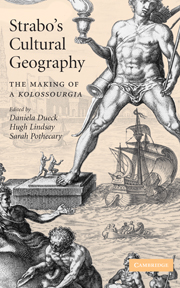Book contents
- Frontmatter
- Contents
- List of maps
- List of illustrations
- List of tables
- List of figures
- List of contributors
- Acknowledgements
- List of abbreviations
- Introduction
- 1 Kolossourgia. ‘A colossal statue of a work’
- 2 Reflections of philosophy: Strabo and geographical sources
- 3 Who is a barbarian? The barbarians in the ethnological and cultural taxonomies of Strabo
- 4 Gender at the crossroads of empire: locating women in Strabo's Geography
- 5 Strabo and Homer: a chapter in cultural history
- 6 Strabo's use of poetry
- 7 Strabo's sources in the light of a tale
- 8 The foundation of Greek colonies and their main features in Strabo: a portrayal lacking homogeneity?
- 9 Ανδρες ἔνδοξοι or ‘men of high reputation’ in Strabo's Geography
- 10 Comparing Strabo with Pausanias: Greece in context vs. Greece in depth
- 11 The European provinces: Strabo as evidence
- 12 Amasya and Strabo's patria in Pontus
- 13 Cappadocia through Strabo's eyes
- 14 Greek geography and Roman empire: the transformation of tradition in Strabo's Euxine
- 15 Josephus' hidden dialogue with Strabo
- 16 Temporal layers within Strabo's description of Coele Syria, Phoenicia and Judaea
- Bibliography
- Index of geographical names
- Index of personal names
5 - Strabo and Homer: a chapter in cultural history
Published online by Cambridge University Press: 18 December 2009
- Frontmatter
- Contents
- List of maps
- List of illustrations
- List of tables
- List of figures
- List of contributors
- Acknowledgements
- List of abbreviations
- Introduction
- 1 Kolossourgia. ‘A colossal statue of a work’
- 2 Reflections of philosophy: Strabo and geographical sources
- 3 Who is a barbarian? The barbarians in the ethnological and cultural taxonomies of Strabo
- 4 Gender at the crossroads of empire: locating women in Strabo's Geography
- 5 Strabo and Homer: a chapter in cultural history
- 6 Strabo's use of poetry
- 7 Strabo's sources in the light of a tale
- 8 The foundation of Greek colonies and their main features in Strabo: a portrayal lacking homogeneity?
- 9 Ανδρες ἔνδοξοι or ‘men of high reputation’ in Strabo's Geography
- 10 Comparing Strabo with Pausanias: Greece in context vs. Greece in depth
- 11 The European provinces: Strabo as evidence
- 12 Amasya and Strabo's patria in Pontus
- 13 Cappadocia through Strabo's eyes
- 14 Greek geography and Roman empire: the transformation of tradition in Strabo's Euxine
- 15 Josephus' hidden dialogue with Strabo
- 16 Temporal layers within Strabo's description of Coele Syria, Phoenicia and Judaea
- Bibliography
- Index of geographical names
- Index of personal names
Summary
This paper discusses and explains Strabo's defence of Homer and thus evaluates Strabo's purpose and attitude to the poet particularly in view of the historical and cultural goals of his Geography. It is mainly in the Prolegomena (books one and two) that we see Strabo's approach toward various adversaries, as he justifies the significant presence of the most authoritative of all poets in his geographical work. In addition, I will try to identify the role played by Homeric traditions in the Geography in general, particularly in books where it is most outstanding, such as the books on Greece and Asia Minor (eight to ten and twelve to fourteen). This identification will be based on explicit statements made by the author.
The main question here is what is the special meaning of this theme in the historical and cultural context of Strabo's work. In my opinion ‘Strabo and Homer’ is an interesting chapter of cultural history that goes beyond Strabo and his work. Our geographer is an important witness to a cultural transmission that allows us to perceive the distance, despite apparent analogies, between the two worlds, the Greek and the Roman, both of which are present in the author's biographical experience and fused into his work.
I begin with a brief survey of modern research on this subject. The large number of Homeric citations in the Geography has always struck modern scholars, starting in the nineteenth century, and it has often negatively influenced evaluations of the author.
- Type
- Chapter
- Information
- Strabo's Cultural GeographyThe Making of a Kolossourgia, pp. 73 - 85Publisher: Cambridge University PressPrint publication year: 2005
- 1
- Cited by

